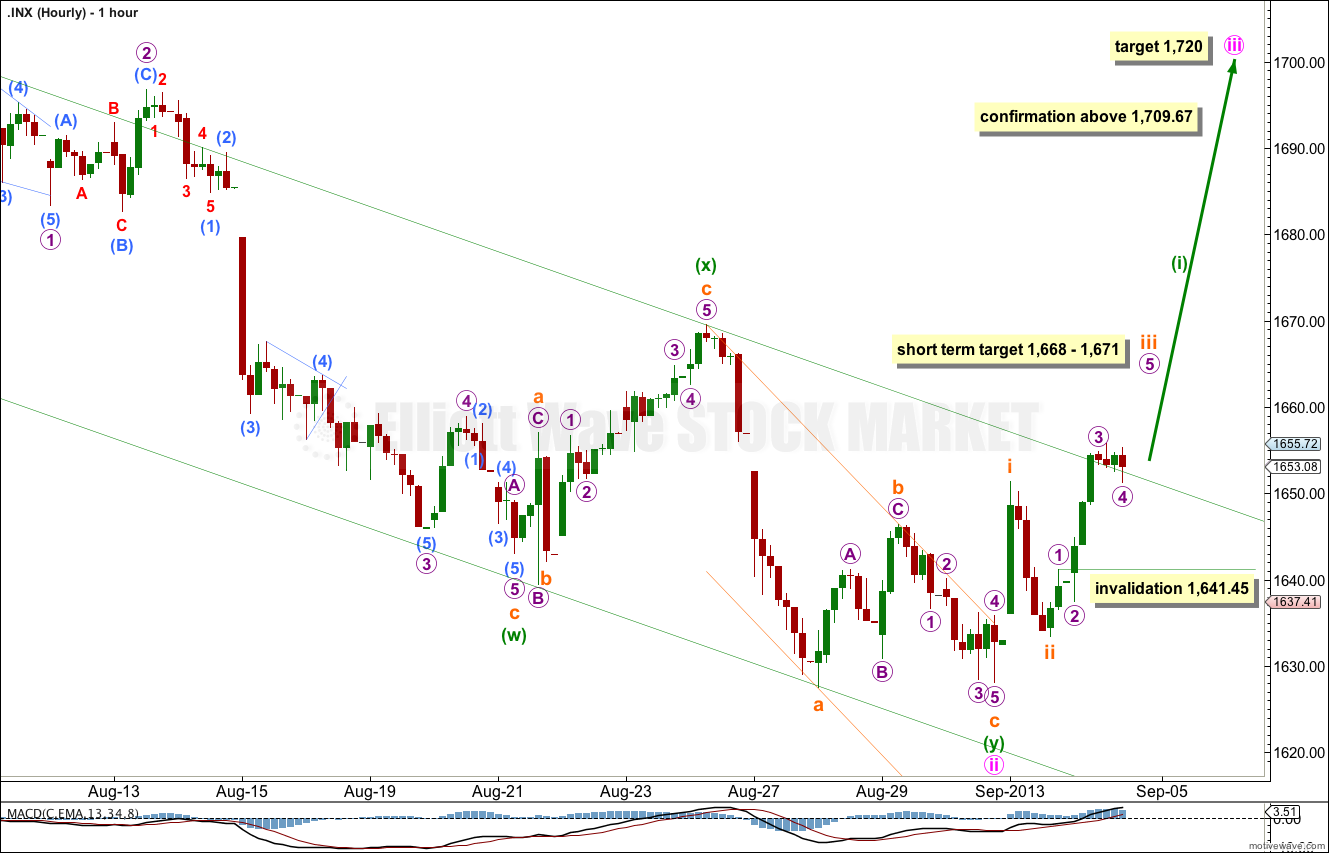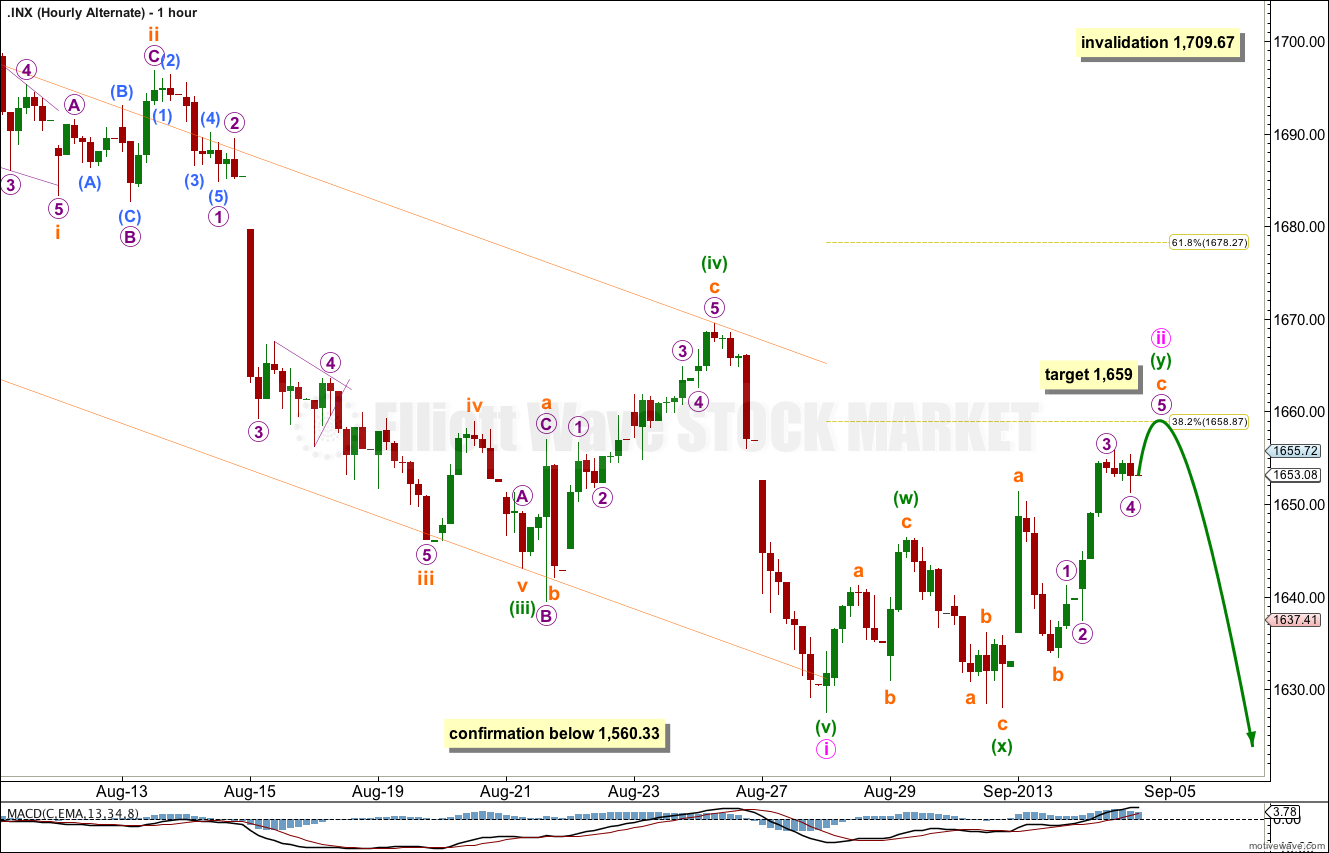Yesterday’s analysis expected upwards movement for the main wave count, which is what happened.
I still have the same two wave counts. We must still favour the main wave count because we should always assume the trend remains the same, until proven otherwise.
Click on the charts below to enlarge.
Main Wave Count.
This wave count agrees with MACD and has some nice Fibonacci ratios in price and Fibonacci relationships in time.
Minor wave 3 is 15.1 points longer than 2.618 the length of minor wave 1.
Ratios within minor wave 3 are: there is no Fibonacci ratio between minute waves iii and i, and minute wave v is 5.44 points longer than equality with minute wave iii.
At 1,740 intermediate wave (C) would reach equality with intermediate wave (A). At 1,739 minor wave 5 would reach 0.618 the length of minor wave 3.
Within minor wave 5 minute wave ii may not move beyond the start of minute wave i. This wave count is invalidated with movement below 1,560.33.
Minor wave 1 lasted a Fibonacci 21 days, minor wave 2 lasted a Fibonacci 8 days, minor wave 3 has no Fibonacci duration at 98 days, and minor wave 4 lasted 22 days, just one day longer than a Fibonacci 21.
Minor wave 5 may not exhibit a Fibonacci time relationship. However, the next Fibonacci number in the sequence is 55 which could see minor wave 5 ending on 10th September (give or take a day or two either side). At this stage it does not look like the structure can complete in so little time.
Keep drawing the wider parallel channels from the monthly chart and copy them over to the daily chart.
Upwards movement for Wednesday’s session shows some increase in momentum. This may be a third wave within minuette wave (i).
Within subminuette wave iii micro waves 1, 2 and 3 are complete. Micro wave 4 is most likely to be complete, but could move further sideways and lower. Micro wave 4 may not move into micro wave 1 price territory. This wave count is invalidated in the short term with movement below 1,641.45.
There is no Fibonacci ratio between micro waves 3 and 1. This means it is more likely we shall see a Fibonacci ratio for micro wave 5 to either of micro waves 3 or 1. At 1,668 micro wave 5 would reach equality in length with micro wave 3.
At 1,671 subminuette wave iii would reach 1.618 the length of subminuette wave i.
When subminuette wave iii is complete the short term invalidation point may move up to the high of subminuette wave i at 1,651.35.
When minuette wave (i) is a completed five wave structure we should expect a deep second wave correction. At that stage the invalidation point would move back down to 1,628.05.
Alternate Wave Count.
While price remains below 1,709.67 it will remain possible that we have recently seen a trend change at cycle degree. However, we should always assume the trend remains the same until proven otherwise.
This is a huge trend change. The new downwards trend should last from one to several years and take price substantially below 666.76. We need some confirmation before having confidence in this wave count.
We should assume the trend is upwards until this wave count is confirmed with movement below 1,560.33, and then with a breach of the black parallel channel on the daily chart.
This wave count is the same as the main wave count, except the degree of labeling in the final upwards wave of minor wave 5 is moved up one degree.
For tomorrow’s session this alternate also expects some upwards movement.
Minute wave ii is most likely unfolding as a double zigzag. The purpose of double zigzags is to deepen a correction when the first zigzag did not move price deep enough, which certainly fits this case.
Minute wave ii could also still be a regular flat correction, but the C wave within it would be so much longer than equality with the A wave (longer even than 1.618 the length of the A wave) and would be still incomplete, that would look strange for a regular flat. A double zigzag has a more typical look.
At 1,659 micro wave 5 within subminuette wave c would reach equality in length with micro wave 1. This would bring minute wave ii up to the 0.382 Fibonacci ratio of minute wave i.
Minute wave ii may not move beyond the start of minute wave i. This wave count is invalidated with movement above 1,709.67.




